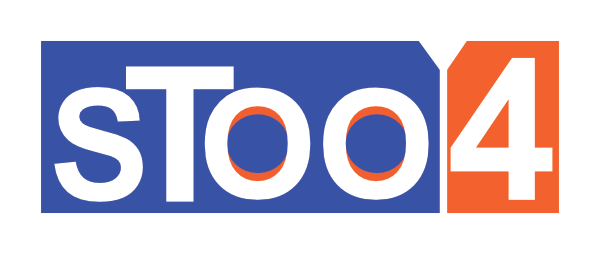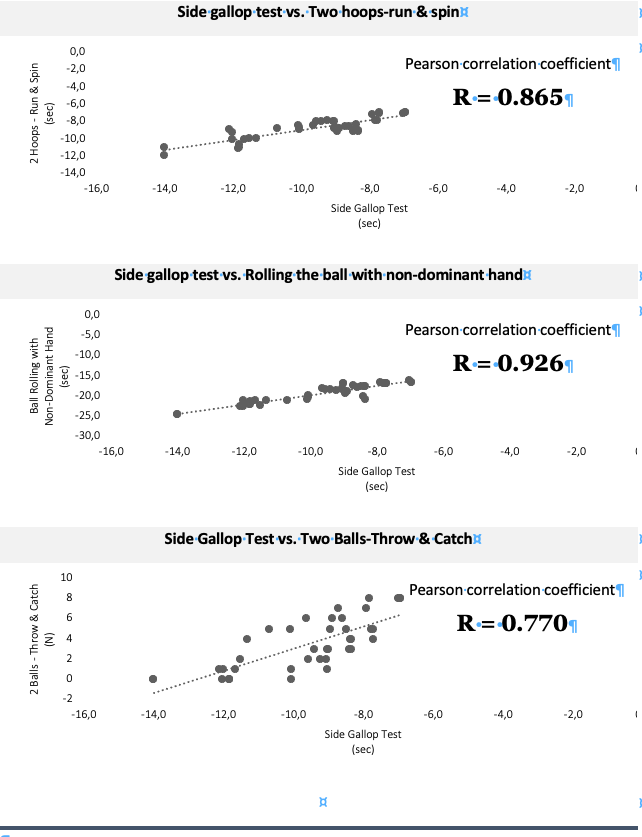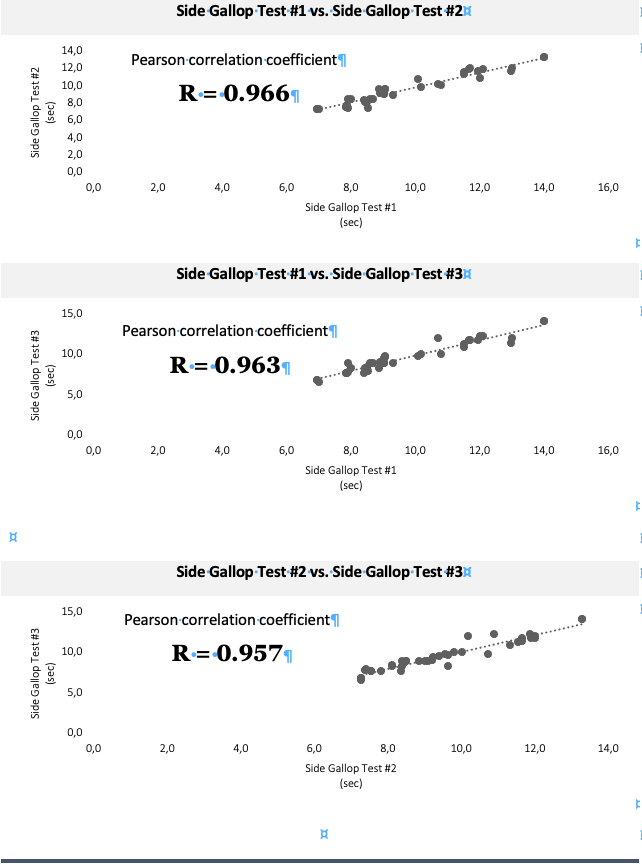Comparison of basic coordination assessment tests with the newly constructed test in rhythmic gymnastics
|
Teaching (Today for) Tomorrow: Bridging the Gap between the Classroom and Reality 3rd International Scientific and Art Conference
|
|
Rebeka Stojković1, Josipa Radaš21Faculty of Kinesiology, Josip Juraj Strossmayer University of Osijek, stojkovicrebeka@gmail.com 2Faculty of Kinesiology, University of Zagreb, josipa.radas@kif.hr |
|
| Section- Kinesiology education and sports | Paper number: 55 |
Category: Original scientific paper |
Abstract |
|
Rhythmic gymnastics is a conventional sport that contains its own artistic component. In addition to the five apparatus that gymnast manipulates with, following the rhythm and tempo of the music, she also controls the movements with her body, which creates unity in the beauty of the performance. The same requires great coordination ability, as one of the most important motor abilities in rhythmic gymnastics. The aim of this paper was to construct a coordination assessment test applicable specifically to rhythmic gymnastics. The sample consisted of 40 rhythmic gymnasts aged 9-12. For coordination assessment, three already known tests and one newly constructed test were used: "Side gallop with rope". The results show that the newly constructed test measures the coordination necessary for the successful performance in rhythmic gymnastics, but only in the observed sample. There is a statistically significant difference between individual measurements (p<0,05) and a statistically significant correlation (p<0,001), therefore this test is considered reliable. It would be good to implement the newly constructed test when selecting children for rhythmic gymnastics program, as well as during transitive measurements in the training process. |
|
Key words: |
|
metric characteristics; motor abilities; newly developed test; rhythmic gymnasts |
Introduction
Motor coordination is no doubt the most important ability in terms of the overall performance and motor behavior of human beings. It is practically implemented in every movement structure, from the simplest to the most complex forms of motion (Purenović – Ivanović, 2014). Success in any sport, as in any other activity, depends on a number of abilities and dimensions that a certain individual must possess. It is very important how developed these abilities are and how far they are from the ideal model (Cvenić, 2007). Coordination as a motor ability is certainly one of the indispensable ones that must be found in every sport. In rhythmic gymnastics, besides flexibility, coordination takes a leading place in the specification equation of motor abilities. It can be manifested in a combination of dance, gymnastics and apparatus handling, movements of impressive motor structures that are characterized by beauty, elegance and harmony, with the constant striving to achieve perfectly coordinated and precisely executed motions and movements (Ivančević, 1976). Due to this, rhythmic gymnastics is a sport which requires the complexity and high level of motor abilities (flexibility, whole – body coordination, dynamic and static balance, whole – body movement time and hand eye coordination) (Pavlova, 2011). Indeed, precise muscular efforts as well as space and time parameters of movements are especially important in this sport (Purenović – Ivanović et al., 2016). Because of the exceptional importance of motor coordination abilities for the performance, as for the processes of orientation, selection and monitoring in the field of rhythmic gymnastics, this issue is given special attention. For the coordination abilities assessment in rhythmic gymnastics, specific tests are suggested (Moskovljević & Orlić, 2012) even though many of the conducted studies were based on general coordination tests. Tomac (2020) constructed a „Tramp jump“ coordination assessment test where the gymnast’s task is to jump over two parallel lines after the initial sign, in such a way that, in each jump, the torso crosses the projection of a vertically placed stand in front of the trampoline. Coordination training athletes specializing in gymnastics should be one of the priorities in the system physical and health culture as well as sport itself, which is proved by Tereschenko et al. (2016), who constructed a specific battery of motor abilities tests and supported the effectiveness of the coordination training program. The aim of this paper is to construct a coordination assessment test applicable specifically in rhythmic gymnastics.
Methods
The sample consisted of 40 rhythmic gymnasts aged 9-12, members of a Rhythmic Gymnastics Club „Rondo“ from Osijek. The participants were measured voluntarily and the parents of the gymnasts gave their written consent for the study. It should be pointed out that the gymnasts were free of injuries, warmed up before the testing and familiar with the protocol of this research. The study was conducted at the sports hall of St. Anne's Elementary School in Osijek. To assess coordination, three familiar tests with verified metric characteristics were used: „two handballs throw“, „run and spin with hoops“ and „rolling the ball with non-dominant hand“. Another new test “Side gallop with rope” was used as well. Tests were performed twice in the same way from the beginning of April to the end of May 2024.
Two balls – throw and catch
The gymnast stands on a straight line with two handballs, one in each hand. The task is to throw the balls into the air at the same time, turn 360° and catch both balls. The examinee gets points on how many balls she catches. Also, it should be pointed out that the spin must be complete 360° otherwise the result is 0 points. The gymnast throw the balls five times in one test. The test is performed three times (Foretic et al., 2010).
Two hoops – run and spin
There are two lines on the ground 750 cm apart and two hoops are placed between them. The distance between the start and the first hoop as well as the distance between the second hoop and the return line is 250 cm. The gymnast stands on the starting line and at the sign runs towards the return line and away from it by running backwards. The task is to enter each hoop and make a 360° spin, two times moving forward and two times backwards. The test is performed three times with 30 seconds breaks (Foretic et al., 2010).
Rolling the ball with non-dominant hand
The purpose of this test is to assess upper extremity coordination, which is defined as the ability to manipulate objects in a space with obstacles. Three parallel lines are marked on the ground, three meters apart. There is one stand placed exactly in the middle of each line. The gymnast starts on the first line, facing the direction of movement and lightly leans the ball with non – dominant hand. On the signal, she rolls the ball on the ground changing the direction between and around the stands. The task is performed in four lengths and completed after the gymnast crosses the finish line. It is performed three times with 30 seconds breaks (Tomljenović, 2018).
Side gallop test with rope
Two parallel lines are marked on the ground, 12 meters apart. The gymnast starts the test standing on the starting line at the signal. The task is to perform the side gallop passing through the rope. When both legs cross the second line, the body turns 180° and the gymnast returns to the starting line performing the same element by passing through the rope backwards. Test is completed after the gymnast crosses the line with both legs and it is performed three times.
Microsoft Excel 365 was used for data entry, preparation and visualization. The statistical analysis was performed on all data using IBM SPSS Statistics 26. To describe sample statistics, average, standard deviation, relative standard deviation, skewness and kurtosis have been used. We also used the Shapiro – Wilk test to determine the significance of deviations from normal distribution and Box – and – Whisker plots to visualise the distributions of results. The Pearson correlation coefficient was used to determine the correlation between the Side gallop test and other coordination tests and to determine relationships between all repetitions of the Side gallop test. All the tests were conducted at the significance level of p=0.05.
Results
Gymnasts had an average result of 9.6 seconds and a standard deviation of ±1.8 seconds on a newly constructed Side gallop test. The tests relative standard deviation is ±18.8% indicating higher sensitivity to ability differences among the sample, compared to Two hoops – run & spin test (SDrel=±13.6%) and Rolling the ball with non – dominant hand (SDrel=±11.9%). However, the Side gallop test has much lower sensitivity than Two balls – throw & catch test (SDrel=±74.3%) (Table1).
Table 1
Descriptive statistics
|
Motor ability test |
N |
AS |
SD |
Shapiro – wilk p value |
Skewness |
Kurtosis |
|
SIDE GALLOP |
40 |
9.6 |
±1.8 |
0.018 |
-0.662 |
-0.282 |
|
2HOOPS |
40 |
8.8 |
±1.2 |
0.087 |
-0.529 |
0.046 |
|
ROLLING |
40 |
19.3 |
±2.3 |
0.008 |
-0.559 |
-0.701 |
|
2BALLS |
40 |
3.5 |
±2.6 |
0.011 |
0.251 |
-1.068 |
The Side gallop test is positively correlated with the other coordination assessment test (Graph 1), which indicates that this newly constructed test indeed measures the coordination. Also, there is a strong correlation between different repetitions of the Side gallop test and it is considered reliable. The gymnasts with above – average results in the Side gallop test, also had high results in other coordination tests and vice – versa. The correlation between the newly constructed test and Two hoops – run & spin test is positive (R=0.865). Also, the correlation between Rolling the ball with non – dominant hand and Side gallop test is positive (R=0.926), so is between the third correlation test – Two balls throw (R=0.77), so the test is considered valid. The correlation between the first and the second measurements is strongly positive (R=0.963). Between the second and the third one is nearly close to it (R=0.957), so is the correlation between the first and the third repetition (R=0.966). According to these results, we consider this test valid and reliable (Graph 2).
Graph 1
Relationship between Side gallop test and other coordination assessment tests
Graph 2
Relationships between different repetitions of Side gallop test
Discussion
Rhythmic gymnastics is a conventional sport where the execution depends directly on the technical mastery, performance of the body elements and the level of motor abilities, in this case, coordination (Mkaouer et al., 2012). According to Miletic (2005), performing speed of acquired motor programs and speed of the adoption of new motor programs is one of the substantial determinants of motor functioning and of the development of the body as a whole. It is known that we distinguish between general and specific coordination, which is also part of technical preparation in rhythmic gymnastics and it is one of the reasons why it is studied in this paper. Rhythmic gymnastics is a sport with a particular training process which requires high volume, very young gymnasts and very early specialization. Also, there are many hours of intensive training per week, lots of repetition and high level of technical elements performed (Bobo-Arce & Méndez-Rial, 2013). There is also a lot of motor information acquired in the early years of life, between five and eight years of age (Miletić et al., 2004). In this study, we focused on a very interesting apparatus – rope. In other sports it is common and often used for explosive strength development, but in rhythmic gymnastics, young athletes use it as one of the first apparatuses besides the hoop. By manipulating the rope, they develop a sense for apparatus manipulation and later more easily manipulate other apparatuses, so it would be good to implement this newly developed test during transitive measurements in the training process. However, every research has its limitations, caused by different reasons: the impossibility of fully realizing the imagined ideas, lack of knowledge that the research points out to us during the implementation itself and sometimes the results themselves indicate limitations. One of the disadvantages of the test is that each gymnast must have her own rope, because the apparatus must fit the size of each gymnast and they are quite morphologically different in this age, especially in height. However, the age group of the population was appropriate because these gymnasts belong to the category of young cadets and one of the required apparatus is the rope, so the test is recommended to be conducted on the population of younger age groups. Also, the rope is an apparatus subject to different working conditions, which means that the test is adaptable to a certain type of ground, whether the training is conducted in the hall or outside on the playground.
Conclusion
The results confirm the hypothesis that the newly constructed test assess coordination, but only in the observed sample, in this case young rhythmic gymnasts, because the test includes specific movements that would be difficult to perform correctly with other athletes. Designing the test for this age group, we concluded that it would be good for future research to make it more difficult and include a body turn by 180° around the vertical axis while performing the Side gallop with a rope and measure the time needed to pass the same distance. Such a test would be applicable for the older population of senior gymnasts who easily manipulate with apparatuses. The rope is certainly one of the basic ones that provide a great possibility for constructing tests for measuring functional and motor abilities, especially in rhythmic gymnastics where the battery of tests is still insufficient.
References
Bobo-Arce, M., & Méndez-Rial, B. (2013). Determinants of competitive performance in rhythmic gymnastics. A review. Journal of Human Sport & Exercise, 8(Proc3), S711-S727.
Cvenić, J. (2007). Neke metrijske karakteristike testa za procjenu koordinacije. Zbornik radova, 16, 415-419.
FIG. (2013). 2013-2016 Code of Points: Rhythmic Gymnastics. Lausanne: FIG. https://www.scottishgymnastics.org/sites/default/files/imce/disciplines/2012%20-%202016%20Rhythmic%20Code%20of%20Points.pdf
Foretić, N., Rogulj, N., & Čavala, M. (2010). Metrijske karakteristike novokonstruiranih testova koordinacije. Zbornik radova, 19, 248-254.
Ivančević, V. (1976). Ritmičko sportska gimnastika: Od igre do umetnosti [Rhythmic sportive gymnastics: From play to an art. In Serbian]. Beograd, RS: Partizan.
Miletić, Đ. (2005). Formiranje antropoloških sklopova u ritmiĉkoj gimnastici [Forming of anthropological sets in Rhythmic gymnastics. In Croatian]. In B. Maleš, & Đ. Miletić (Eds.), Antropološki sklopovi sportaša [Anthropological sets in athletes. In Croatian], (pp. 51-93). Split, HR: Faculty of Science and Kinesiology of University in Split.
Miletić, Đ., Katić, R., & Maleš, B. (2004). Some anthropologic factors of performance in rhythmic gymnastics novices. Collegium Antropologicum, 28(2), 727-737.
Mkaouer, B., Amara, S., & Tabka, Z. (2012). Split leap with and without ball performance factors in rhythmic gymnastics. Science of Gymnastics Journal, 4(2), 75-81.
Moskovljević, L., & Orlić, A. (2012). Relations between students’ abilities and attitudes and success in rhythmic gymnastics – gender specificities. Physical Culture, 66(2), 129–137.
Pavlova, E. G. (2011). Vestibular stimulation and cardiovascular changes in 10-12-year-old rhythmic gymnasts. In I. Prskalo, & D. Novak (Eds.), Proceedings Book of 6th FIEP Congress “Physical education in the 21st century - Pupils’ competencies”, (pp. 587-592). Poreĉ, HR: Croatian Kinesiology Federation.
Purenović-Ivanović, T. M., Popović, R., Stanković, D., & Bubanj, S. (2016). The importance of motor coordination abilities for performance in rhythmic gymnastics. Facta Universitatis, Series: Physical Education and Sport, 63-74.
Tereshchenko, I. A., Otsupok, A. P., Krupenya, S. V., Liauchuk, T. M., & Boloban, V. N. (2015). Coordination training of sportsmen, specializing in sport kinds of gymnastics. Physical education of students, 19(3), str. 52-65. doi:10.15561/20755279.2015.0307
Tomac, Z. (2020). Metric characteristics of the measuring instrument for coordination assessment. Homo Sporticus, (1).
Tomljenović, B. (2018). Struktura i razlike antropoloških obilježja učenika i učenica razredne nastave gradskih i seoskih sredina Like (Doctoral dissertation, University of Zagreb. Faculty of Kinesiology).
Komparacija bazičnih testova za procjenu koordinacije s novokonstruiranim testom u ritmičkoj gimnastici
Sažetak |
|
Ritmička gimnastika je konvencionalni sport koji sadrži svoju umjetničku komponentu. Osim što manipulira s pet rekvizita prateći ritam i tempo glazbe, ritmičarka kontrolira zadane pokrete tijelom, što čini jedinstvo u ljepoti izvedbe. Za isto je potrebna velika sposobnost koordinacije, kao jedne od najvažnijih motoričkih sposobnosti u ritmičkoj gimnastici. Cilj rada bio je konstruirati test za procjenu koordinacije primjenjiv specifično za ritmičku gimnastiku. Uzorak ispitanica činile su 40 ritmičarki u dobi od 9 – 12 godina. Koordinacija je procijenjena s već tri poznata testa i jednim novokonstruiranim testom: „Galop strance kroz vijaču“. Rezultati pokazuju da isti procjenjuje koordinaciju potrebnu za uspješnu izvedbu elemenata u ritmičkoj gimnastici, no samo na promatranom uzorku ispitanica. Postoji statistički značajna razlika između pojedinih mjerenja (p<0,05) i statistički značajna korelacija (p<0,001), stoga se ovaj test smatra pouzdanim. Bilo bi dobro da se novi test implementira kod odabira djece za selekciju u ritmičkoj gimnastici kao i kod prolaznih mjerenja u trenažnom procesu. |
|
Ključne riječi: |
|
metrijske karakteristike; motoričke sposobnosti; novokonstruirani test; ritmičarke |



